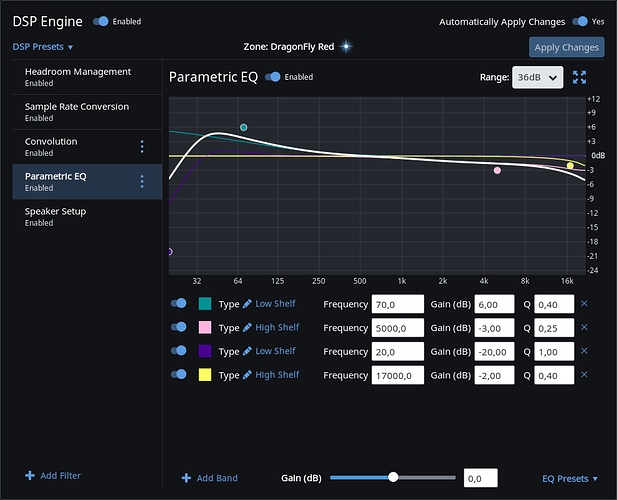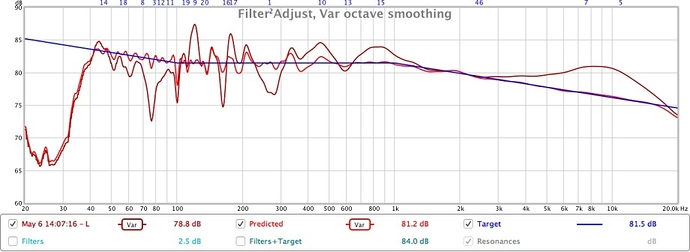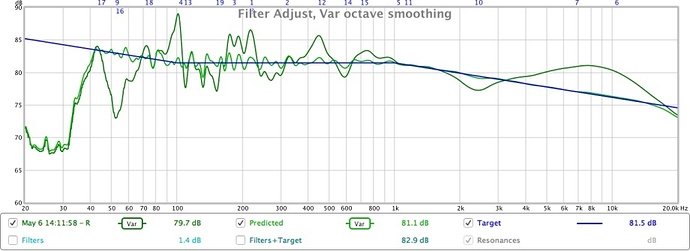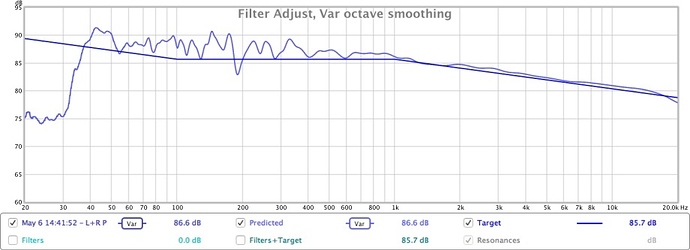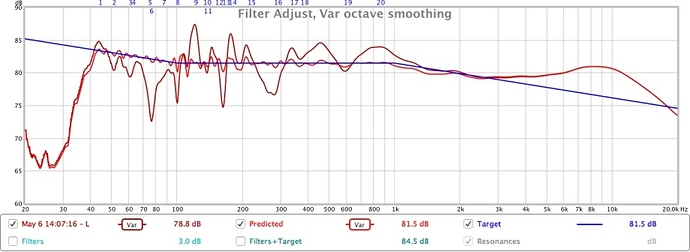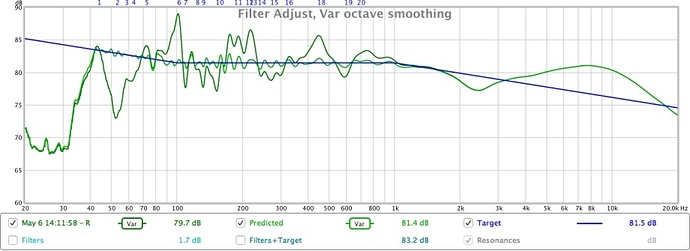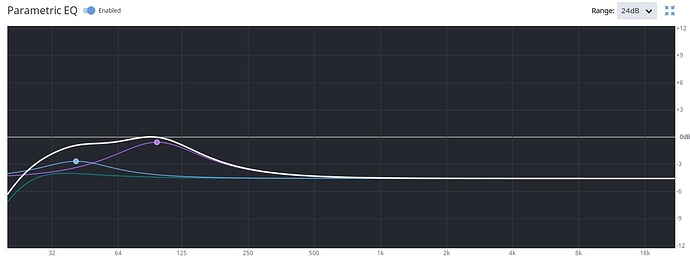OK, a bit more detail…
It was REALLY windy today outside, and living in a city doesn’t help things like measurements - I must have picked literally the worst time - people outside slamming car doors, horns, people talking, leaves in the trees blowing like mad… Actually I think it was like that last year on the day I did my Dirac measurement!
Anyway, I had a short window with the house to myself and a gap in work, so had to just get it done.
I’ve read this guide a few times and played with REW in the interim, but I wasn’t 100% sure I knew what to expect.
I wanted to do it all through Roon since thats one of the benefits of the Pink Noise techniques - that there’s no phase/timing stuff - and it seemed sensible to use the whole chain from the start as I’d like to measure the result too.
I saved out the Pink PN as Wav files, (and a log sweep for later) and added to Roon. I was a bit confused as to whether the volume levels were baked into the files so I just ignored and moved on.
I made a zone from my laptop, using Devialet AIR (wirelessly on this occasion) to the Amp. That worked surprisingly well. So, long USB cable on the Umik-1, into laptop, and on to the Amp via Roon and Devialet virtual sound driver.
So far so good.
The first faff was realising that I needed to mute one speaker at a time. I found the answer in Roons procedural EQ > ‘Mute Channels’ filter. (If I did it again I’d save presets so I didn’t have to keep going in through the menus to toggle the channels on and off).
Setting the levels made me fear for my speakers a bit. I ended up at about 70dB, and even then I stuck my Senheissers on for a bit of protection (and sorry neighbours). I’m not sure if PN is harder on the speakers at not - especially since the averaging method means its putting that noise out for extended periods - but in any case I erred on the side of caution and didn’t go as loud as I should. There’s a lot of b/g noise where I live so 75 would have been better for sure, but even at 70 the amp was up pretty high for my listening levels.
On the the measurements. That was kind of OK. I forgot a few of the settings in the RTA window, and didn’t quite have the technique of what to press in what order. Took a few goes to get it right - the Pink noise is pretty distracting so once that was running I tried to get the rest done quickly. The it took a few goes at a technique for moving the mike- speed and path. Obviously its not possible to get out of the way like it is with log sweeps with the mic on a stand, but I used the pole part of the stand to get a bit of separation.
Measurements done, I went through the tutorial again and played with EQ - following the same settings as much as possible.
After I’d done the first channel I was pretty confused about what to do next. I couldn’t for the life of me work out how to save the result, or how to view it back in the main window. Re-read the guide a few times to see if I was missing a step. No, just couldnt get it. It later dawned on me that maybe there was no way to save and REW just kept it ‘live’. It worked for me that way, but if there;s a better way Id like to know.
I did the other channel, even letting some bass frequencies boost (I was in a rush), exported them (a bit tedious - shame REW doesn’t just have an ‘export for all sample rates’ feature), and pulled the zip into Roon.
Voila!
It worked. Except it sounded distorted. I see the clipping light very firmly ON!
OK so this bit I really don’t understand, because my target meant nothing was boosted above the average measured signal, so I wouldn’t have expected clipping. Maybe this is where my understanding falls down vs Dirac. It actually took a -10dB headroom to get the clipping under control, and it seemed to me this should have been an option in the convolution itself? Other wise if I disable convolution, I’ve got a bit volume drop. That said, when I disabled convolution the volume didn’t change, so I’m not sure why there’s so much clipping if the filter isn’t making the sound louder? One to research further another time…
Anyway, first impressions after the shock of distortion was pretty good. As you’ll see from my measurements below I’ve got a horrible room, and uncorrected sound isn’t very nice - lots of bass suckout and boom, and excess treble - the result a thin and slightly harsh sound. Through PMC’s that are pretty unforgiving, its been killing me not having Dirac running - finding it was a revelation.
With the Convolution, things are much like the generic PEQ I was using previously in terms of overall sound feel, but with much more definition and better stereo image. The PEQ had taken ages to get to where Id ended up - eyeballing from old Dirac screenshots - and was never quite right. Looking at the difference between left and right speakers its obvious thats a lot of the issue.
Tonight I’ve had a bit of time to play with REW and try and make some better filters and house curves. Shame you can’t just click and draw a curve, but I see Magnus posted above how to get a curve in using numbers, so I may try this. Hopefully get a chance to listen to it properly tomorrow.
Here are the ‘pointing to ceiling’ measurements (I may have messed up saving the 0degree ones). Sadly I ran out of time to measure the result which is annoying as thats the bit Im most interested in and not sure when I’ll be able to get all the kit out again, but never mind. Little steps…
Some observations / questions / thoughts from todays session:
-Log Sweeps are definitely nicer to listen to than Pink Noise!
-There’s an uncertainty in my mind about the technique for moving the mic - in terms of speed/distance/duration.
-Are the speakers being stressed? How long is too long when playing pink Noise at relatively high volume?
-Its a real shame REW writes out a convolution file only of the PEQ’s and not the complete picture of the PEQs and the measured values, which used together could give an absolutely perfect result and contain a lot more detail and precision.
-Ultimately, it would be easier if it were possible to import PEQs from REW, into L and R channels in Roon. That way you would also get a visual indicator in Roon, and could manipulate the EQ’s further.
-I would never have been able to work this out alone - complete respect to Magnus for taking the time to document this approach and all the steps needed!
-I’m not 100% sure I had the correct calibration file. I added one in the settings, but when I connected the Umik, REW prompted for a calibration file. When I changed from horizontal to vertical, Im not sure the caleb file was picked up. Seems its not that important - not relative to my room anyway!
-Dirac still wins hands down for ease of use, and UI, but then again its relatively expensive, and cant be used with Roon so isn’t an option. That said, I think this whole setup restricts Room Correction in Roon to the more adventurous and technically minded people (and its already limited to that to some degree already), which is a shame.
 )
)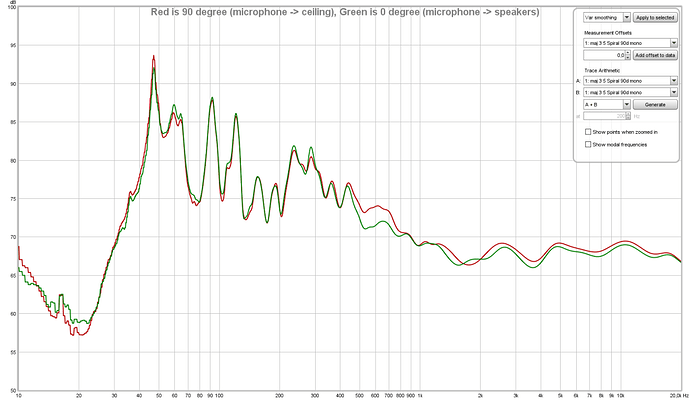

 But since it is all in the 20Hz - 50Hz range, I’m not sure I would be able to track it down. It’s incredibly frustrating as I feel that I am so close to a much better room correction – for my room since the 0˚ meant that my spirals should have always been pointing fairly accurately and consistently at the respective speaker and as I am not sitting far from the speaker the margin of error is quite high. The 90˚ calibration and orientation should decrease that sensitivity.
But since it is all in the 20Hz - 50Hz range, I’m not sure I would be able to track it down. It’s incredibly frustrating as I feel that I am so close to a much better room correction – for my room since the 0˚ meant that my spirals should have always been pointing fairly accurately and consistently at the respective speaker and as I am not sitting far from the speaker the margin of error is quite high. The 90˚ calibration and orientation should decrease that sensitivity.
